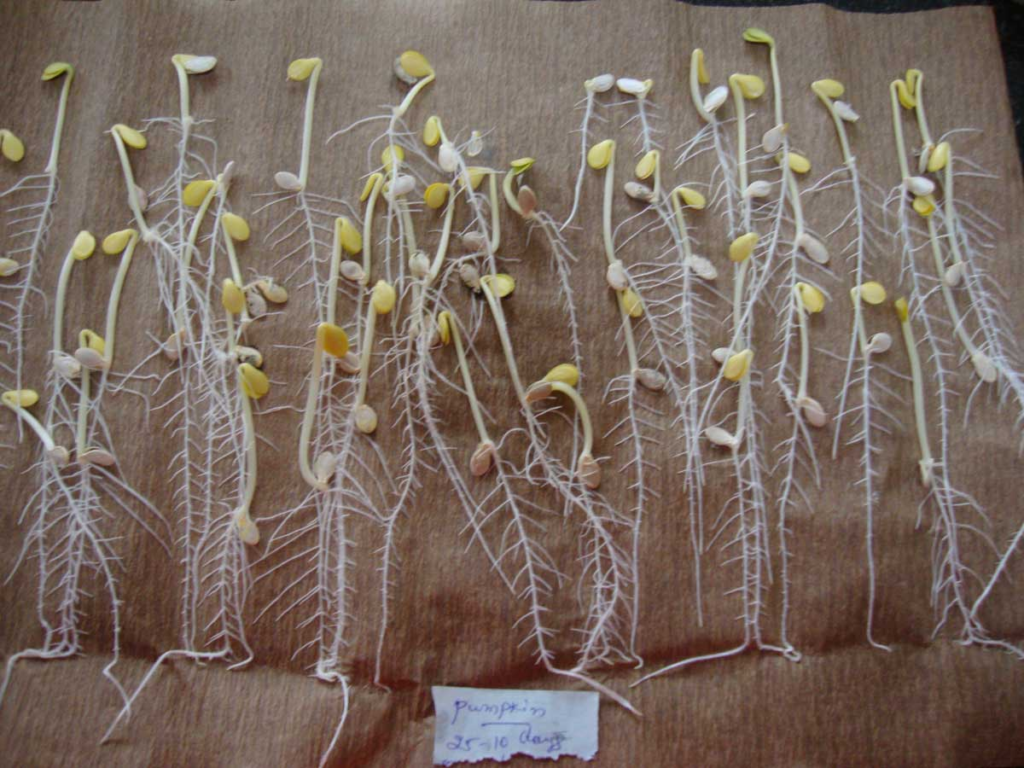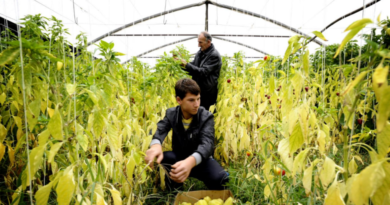Seed Plant Production Supervisor 6 month course
Seed Plant Production Supervisor

Seed Production Manager Manages the planning and management of seed production according to plant needs. Brief description of the job: Seed Production Supervisor Manages and manages the seed production activities in the plant. He is expected to apply knowledge of production methods, processes, machinery and equipment, review and edit product order and ensure that the seed produced meets the expected standards. Your Qualifications: Planting Seed Production Supervisor must have the ability to plan, organize, measure, calculate, concentrate and manage stress. One must have reading, writing and communication skills. In addition, that person should have mechanical skills and shooting problems.

Ensure preparation and maintenance of work area and process machineries for seed processing Seed Plant Production Supervisor:
In order to be effective, each user / individual must be able to: PC1. ensure the cleanliness and maintenance of the workplace using cleaners (keep them free of dust, debris and insects) PC2. ensure that the workplace is safe and clean when processing PC3 seeds. ensure that waste is disposed of in accordance with organizational and industry requirements Ensuring the maintenance and repair of process equipment and seed processing tools In order to operate, the user / individual must be able to: PC4. ensure that the equipment and tools used are cleaned with the recommended cleaners, in accordance with the specifications and standards of the PC5 organization. ensure that the required process tools are installed on PC6. ensure that minor repairs / defects of all equipment are maintained, if required PC7. ensure the selection and placement of equipment and tools, as required
Organizational Context (Knowledge of the company / organization and its processes):
The user / person at work needs to know and understand: KA1. organizational standards, policy principles and procedures in the organization for the use of KA2 seeds. business code of conduct KA3. dress code to be followed by KA4. job responsibilities / tasks and general seed processing procedures KA5. internal processes such as procurement, asset management, quality management and key communication solutions
Technical Knowledge:
The user / person at work needs to know and understand: KB1. the types of chemicals, building materials and equipment needed to clean and maintain KB2. disinfection process equipment / tools KB3 tools. supplier / manufacturer’s instructions relating to the cleaning and maintenance of KB4. Information on workplace legal regulations such as health and safety, recommended use of sanitation facilities, health hazard control, handling / storage / disposal / warnings on the use of cleaners and disinfectants, fire warnings, emergence, hygiene procedures, waste disposal, environmental protection etc. KB5. technology for seed production of various plants and relevant details


Core Skills/ Generic Skills:
The user / person at work needs to know and understand how to do this: SA1. note the details referred to SA2. be aware of the raw materials used in production and finished products manufactured by SA3. note the reading of the process parameters and provide the necessary details to complete the SA4 process chart. note observations (if any) related to procedure SA5. write information documents to internal departments / internal parties SA6. write down ERP details online or through the organization’s Learning Skills The user / person at work needs to know and understand how to do it: SA7. read and interpret the process required to produce different types of SA8 products. read and interpret and analyze the flow chart of all SA9-produced products. read the equipment manuals and processing documents to understand the operation of the equipment and the required process SA10. read internal information documents sent to internal groups Oral Communication (Listening and Speaking Skills) The user / person at work needs to know and understand how to do this: SA11. discuss job lists, schedules and activities SA12. contacting team members SA13. question to understand the nature of the problem and to clarify the questions SA14. listen to and understand the information provided by speaker SA15. liaising with crooks department teams on the issues they face during the process B. Making a Professional Skills Decision The user / employee needs to know and understand how to do this: SB1. analyze critical points in daily activities with experience and observation and find control measures to solve the SB2 problem. manage issues in case the administrator is unavailable (according to the organization’s matrix of authority)
The user / person at work needs to know and understand how to do it: SB3. planning and planning work and activities have received SB4. arrange the materials and packaging materials required for all products following SB5 instructions. edit and edit work based on SB6 instructions. plans to use SB7 for time and equipment. edit all process / equipment manuals and therefore in SB8 access details. to support the manager in organizing the services of assistants (i) Customer Customers The user / person on the job needs to know and understand how to do this: SB9. understand customer needs and priorities and respond according to their needs Troubleshooting SB10.support manager troubleshooting by identifying problems SB11.discipline possible solutions with problem solving manager Analytical Thinking The user / employee needs to know and understand: SB12. use domain information about maintenance procedures and technical information on tools and equipment Key considerations The user / employee needs to know and understand how to do so: SB13. use common sense and make daily judgments SB14. use consulting skills to identify and resolve basic SB15 problems. use the sensor to detect any problems that may occur during SB16 operation. apply the acquired knowledge of the process of identifying and handling issues
Prepare for production of seeds in seed processing plant Seed Plant Production Supervisor:

In order to be effective, each user / individual must be able to: PC1. submit and review the weekly / monthly production order from the manager and understand the production details such as seed type, quantity, details and delivery plan to schedule PC2 seed production. set the sequence of seed production by: calculating batch size based on production order and machine capacity Use of editing equipment and staff capacity To be competent, each user / individual must be able to: PC4. plan to use multi-seed equipment without affecting grain quality, and increase PC5 production and energy efficiency. ensure the functionality and performance of each machine and PC6 of each machine. adjust the shift schedule for machine operators and other PC7 assistants. assign tasks and service to operators and assistants Arrange raw seeds and packaging materials To be effective, the user / individual must be able to: PC8. check the availability of raw seeds, packaging materials, equipment and power for PC9. ensure the transfer of raw seeds and packaging materials from storage to packaging and packaging by PC10 assistants. check the weight of raw seeds and packaging materials found in the storage area and check its consistency and quality standards with body parameters such as appearance, color, texture, etc. PC11. ensure high quality documentation from the provider and the internal lab to ensure its compliance with standards

Organizational Context (Knowledge of the company / organization and its processes) Seed Plant Production Supervisor:
The user / person at work needs to know and understand: KA1. seed production process followed by KA2. types of machinery used for seed processing in the KA3 organization. organizational standards, procedures and procedures in the organization for seed processing KA4. business code of conduct KA5. dress code to be followed by KA6. job responsibilities / tasks and general seed processing procedures KA7. internal processes such as procurement, asset management, quality management and key communication solutions
Technical Knowledge:

The user / person at work needs to know and understand: KB1. various machines used in the organization KB2. maintenance of each of the KB3 process equipment. manufacturer / manufacturer instructions related to KB4 equipment. manages all KB5 processing equipment. basic statistics KB6. quality parameters and quality testing are based on the KB7 parameters. cleaning procedures such as CIP and COP KB8. seed production technology for various plants and relevant details KB9. disinfectant cleaning equipment and handling and maintenance methods KB10. GMP
Core Skills/ Generic Skills:
The user / person at work needs to know and understand how to do this: SA1. note the details referred to SA2. be aware of the raw materials used in production and finished products manufactured by SA3. note the reading of the process parameters and provide the necessary details to complete the SA4 process chart. note observations (if any) related to procedure SA5. write information documents to internal departments / internal parties SA6. write down ERP details online or through the organization’s Learning Skills The user / person at work needs to know and understand how to do it: SA7. read and interpret the process required to produce different types of SA8 products. read and interpret and analyze the flow chart of all SA9-produced products. read the equipment manuals and processing documents to understand the operation of the equipment and the required process SA10. read internal information documents submitted by internal groups
The user / person at work needs to know and understand how to do this: SA11. discuss job lists, schedules and activities SA12. contacting team members SA13. question to understand the nature of the problem and to clarify the questions SA14. listen to and understand the information provided by speaker SA15. liaising with anti-corruption department teams on the issues they face during the process B. Making a Professional Skills Decision The user / employee needs to know and understand how to do this: SB1. analyze critical points in daily activities with experience and observation and find control measures to solve the SB2 problem. manage issues in case the administrator is not available (according to the authorization matrix defined by the organization) Plan and Edit The user / employee needs to know and understand how to do this: SB3. planning and planning work and activities have received SB4. arrange the materials and packaging materials required for all products following SB5 instructions. plan and focus on work based on the instructions received by SB6. plans to use SB7 for time and equipment. edit all process / equipment manuals for SB8 access details. to support the manager in organizing the services of assistants (i) Customer Customers The user / person on the job needs to know and understand how to do this: SB9. understand customer needs and priorities and respond according to their needs Troubleshooting SB10.support manager troubleshooting by identifying problems SB11.discipline possible solutions with problem solving manager Analytical Thinking The user / employee needs to know and understand: SB12. use domain information about maintenance procedures and technical information on tools and equipment Key considerations The user / employee needs to know and understand how to do so: SB13. use common sense and make daily judgments SB14. use consulting skills to identify and resolve basic SB15 problems. use the sensor to detect any problems that may occur during SB16 operation. apply the acquired knowledge of the process of identifying and handling issues
Supervise production of seeds in seed processing plant Seed Plant Production Supervisor:
In order to be effective, each user / individual must be able to: PC1. inspect and verify the hygiene and sterilization of all seed processing equipment such as cleaner, scalper, air screen cleaner, gravity separator, integrated cylinder, bucket elevator, treater, etc. PC2. check and verify that the repairs are stored on all seed processing equipment and PC3 equipment. check and make sure all process equipment is clean and in good condition for PC4. check the installation of components such as valves, containers, plates, disks, pipes and other components in the equipment and ensure that all equipment is ready for PC5 production. start each processing equipment and verify its functionality and functionality and check whether the required tools are stored for repairs / errors in case of demolition Monitoring the production and processing of seeds To be effective, each user / individual must be able to: PC6. update production orders or schedules to obtain product details such as seed type, quantity, seed details to plan PC7 performance. check and make sure the production area is safe and clean PC8. check control points and equipment periodically to ensure the best performance and performance of the PC9. stop production following a stopping process, in the event of a breakdown during PC10 production. co-operating with the nutrition team and ensure that equipment damage is addressed promptly to prevent PC11 operating delays. suggest control methods and remedial actions on any production-related problems, processes and products, if you need to contact a manager and resolve PC12 issues. ensure seed quality by establishing and enforcing organizational standards at each stage of the PC13 production process. monitor seed packaging, perform a random check on the weight of the packaged seed, check label details such as date of manufacture, batch number, etc. and make sure the seeds are packed according to the organization and PC14 control standards. to monitor production activities, to coordinate with the cross-team work team and
\ensure that the product is started and finished as planned PC15. ensure timely production with minimal or no damage at all, and ensure that the quality of the seed produced meets the organization and regulatory standards of PC16. analyze product performance records and data, investigate issues related to seed processing, identify solutions, recommend corrective action and verify implementation of the proposed PC17 action. check out new equipment and techniques for the installation of new PC18 equipment. keep the workplace safe and clean by teaching the team about PC19 compliance procedures. monitoring functions and performance of assistants, technicians, operators and assistants PC20. provide production information to the manager by compiling, filtering, and analyzing product performance records for all PC21 shifts. review the administrator in daily activities, discuss the issue, suggest or understand the counter-prevention and remedial action, and take immediate steps to fix PC22. contribute to the team’s effort by managing production activities without assistants or staff shortages, achieving the required outcomes Ensuring the final production cleanliness and general maintenance of equipment In order to be competent, the user / individual must be able to: PC23. workplace cleaning views, equipment and tools using recommended agents and PC24 sanitizers. ensure minor repairs / errors (if any) of all items and equipment being considered before the start of the next PC25 production. ensure regular maintenance (daily / weekly / monthly / quarter / quarter / half / year / year) all equipment and resources that follow the SOP or follow instructions / manual suppliers Management and training team In order to be effective, user / individual must be able to: PC26. motivating staff, initiating and developing inter-departmental and inter-departmental collaboration, enhancing personal growth opportunities PC27. maintain effective manager-employee relationships, build a safe working environment, build effective communication channels, identify and resolve employee problems, manage conflicts, respond to PC28 complaints. managing staff performance and team performance, providing new staff recruitment, educating the team on compliance procedures, training or providing adequate training and motivating employees PC29. trainers, advisors and staff members, initiate, coordinate and implement systems, policies and procedures through the PC30 team. inspect, investigate complaints or performance concerns, and apply disciplinary action as required in consultation with the appropriate authority

Organizational Context (Knowledge of the company / organization and its processes) Seed Plant Production Supervisor:
The user / person at work needs to know and understand: KA1. organizational process and process KA2 seed production process. the mechanism of machinery used for seed processing, as defined in the general operating procedures of the KA3 organization. organizational standards, procedures and procedures in the organization for seed processing KA4. business code of conduct KA5. dress code to be followed by KA6. job responsibilities / tasks and general seed processing procedures KA7. internal processes such as procurement, asset management, quality management and key communication solutions
Guidelines for Assessment:
- Criteria for assessment for each Qualification Pack will be created by the Sector Skill Council. Each Performance
Criteria (PC) will be assigned marks proportional to its importance in NOS. SSC will also lay down proportion of
marks for Theory and Skills Practical for each PC - The assessment for the theory part will be based on knowledge bank of questions created by the SSC
- Individual assessment agencies will create unique question papers for theory part for each candidate at each
examination/training center (as per assessment criteria below) - Individual assessment agencies will create unique evaulations for skill practical for every student at each
examination/training center based on this criteria - To pass the Qualification Pack , every trainee should score a minimum of 70% in aggregate
- In case of successfully passing only certain number of NOS’s, the trainee is eligible to take subsequent
assessment on the balance NOS’s to pass the Qualification Pack






